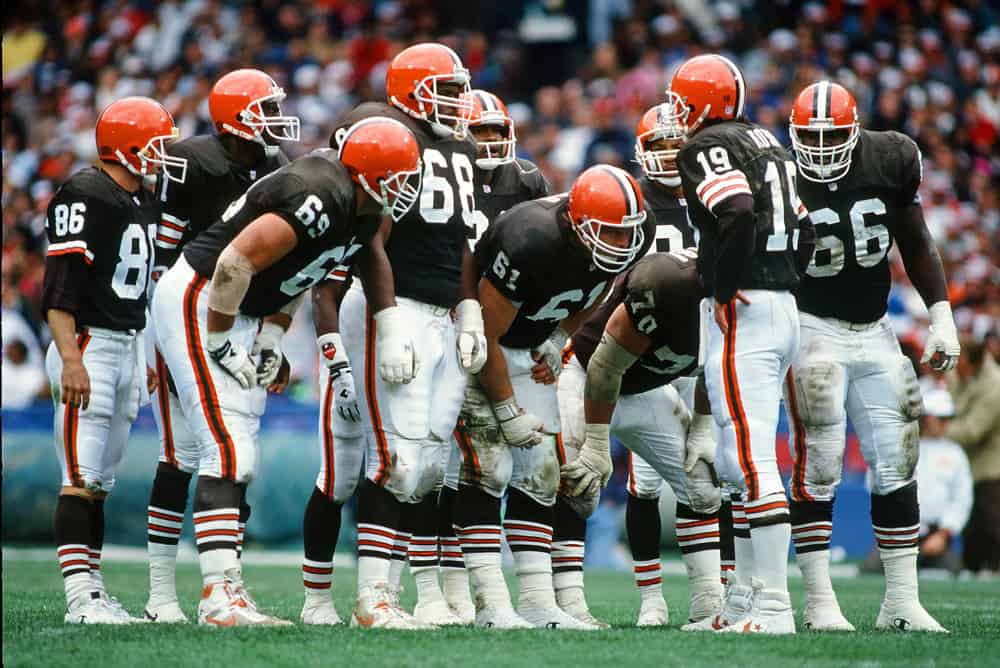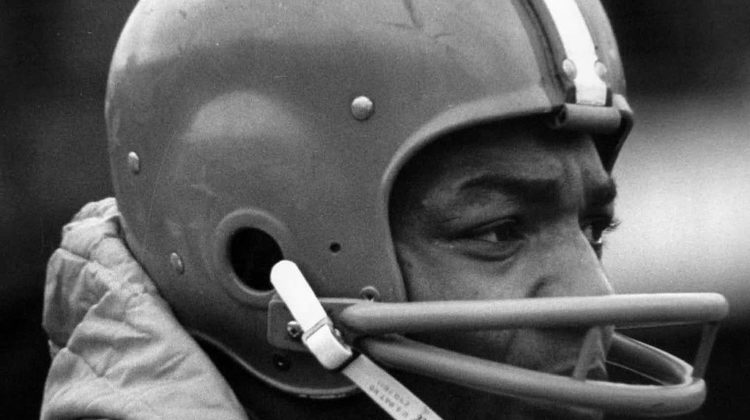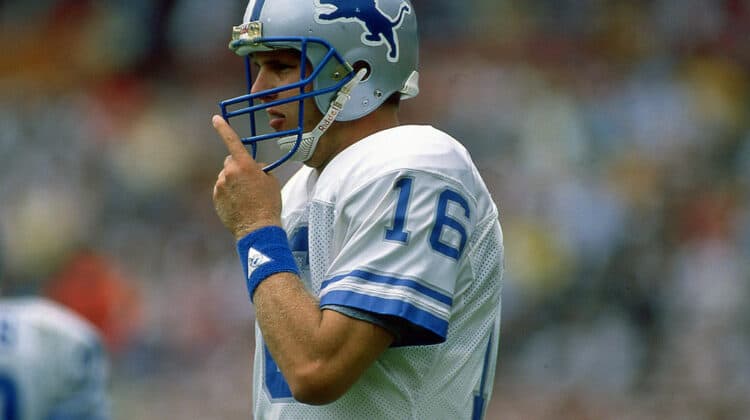
In the mid-late 1980s, the Cleveland Browns had a playoff resurgence.
On three occasions from 1986-1989, the team went to the AFC title game where they lost to the Denver Broncos each time.
During this run of success, the Browns assembled a motley group of players on both sides of the ball.
In particular, the Browns began a shift around 1986 from a run-oriented to a pass-oriented offense.
This change was done in part to meet the style of quarterback Bernie Kosar who, poor mechanics aside, could sling the ball.
Between 1984-1986, Cleveland drafted receivers Brian Brennan, Reggie Langhorne, and Webster Slaughter.
These three helped pace the Browns offense through their glory years.
By the early 90s, all three had moved on to finish their careers with other teams.
And, as is the case with any athlete, by the time Brennan and Slaughter retired, their ability was already in decline.
However, when Langhorne retired as a member of the Colts after the 1993 season, many fans and NFL front office personnel were stunned.
Langhorne had just wrapped up his best year as a pro and then suddenly, inexplicably, retired from the game.
Why did he walk away from a potential big pay day and a significant elevation of fame?
This is a closer look at the life, career, and curious retirement of Reggie Langhorne.
High School and College
Reginald “Reggie” Langhorne was born on April 7, 1963 in Suffolk, Virginia.
His interest in athletics led him to play football for Smithfield High School in Smithfield, Virginia.
Since Smithfield was a small program, Langhorne didn’t make much noise as an athlete.
After graduating high school, Langhorne decided to attend Elizabeth City State University in Elizabeth City, North Carolina.
He went to Elizabeth City not to shine on the football field, but to take part in the school’s ROTC program.
While partaking in ROTC, Langhorne also played on the ECSU football team.
During his four years with the Vikings, Langhorne wasn’t exactly a star, but he wasn’t anonymous either.
By the time college graduation rolled around, it wasn’t a given that Langhorne would be in the NFL.
It helped that, at the time, the United States Football League (USFL) was in existence and also looking for players.
That is how Langhorne was discovered by the pros.
Langhorne went with the advice of his agent and took his chances that he would be selected by an NFL team in the 1985 draft.
At that time, the draft had 12 rounds, so there was a pretty fair chance that even small school guys could be selected in the later rounds.
That’s exactly what happened when the Browns drafted Langhorne with the number 175th pick of the 7th Round.
Reggie Langhorne
ECSU Graduate
Drafted Round 7 Pick 175
Cleveland Browns 1985-1991 (NFL)
Indianapolis Colts 1992-93 (NFL) pic.twitter.com/b6iBAz10nG— ECSUVikingFootball (@ECSUVikingFBall) June 4, 2020
Enter the Dawg Pound
Langhorne’s rookie year in Cleveland coincided with the rise of the Brown’s franchise.
He also happened to witness the birth of the “Dawg Pound” in 1985.
In training camp that year, defensive backs Hanford Dixon and Frank Minnifield decided to call their defensive mates (particularly the Browns defensive linemen) Dawgs and the opposing quarterback would be the cat.
In 1985, Hanford Dixon and Frank Minnifield, cornerbacks for the Cleveland @Browns, began barking at their defensive linemen — an unconventional rallying cry. The rest is Dawg Pound history. https://t.co/4IjsmRPWj5 pic.twitter.com/cYSbLRzdkb
— Stephen Hiltner (@sahiltner) February 4, 2018
Beginning in training camp, and throughout the season, the defense, along with their rabid fans, would bark after big plays.
Because the Browns ran a run-first offense that season, Langhorne didn’t see much playing time, as is evidenced by his one reception for 12 yards stat line in 1985.
Where Langhorne earned his bread and butter was on special teams.
Langhorne Becomes a Starter
Before Langhorne’s second season with the club in 1986, Cleveland hired former Bengals offensive coordinator Lindy Infante to be their offensive coordinator.
This would prove to be a significant move for the Browns.
Infante wanted to open up the team’s offense more to showcase Bernie Kosar’s talent.
Langhorne immediately became a recipient of this change and he went from one catch in 1985 to 39 receptions for 678 yards in ‘86.
Good talk w/ former @Browns WR Reggie Langhorne on the #Steelers–#Browns rivalry.
“I didn’t do much talking… I was 6’5″ – defensive backs didn’t do much talking at me. I was a country boy at heart & was there to be a good blocker too, so you didn’t want to make me angry.” pic.twitter.com/y6ciR8gflq
— Steelers Takeaways 🌗 (@PittsburghSport) November 17, 2019
1986 was also the year Cleveland drafted receiver Webster Slaughter out of San Diego State.
Between Brian Brennan (drafted in 1984), Slaughter, and Langhorne, the Browns offense suddenly had a very potent receiving core.
Did someone say #NationalHighFiveDay?#TBT to WRs Reggie Langhorne (88) and Webster Slaughter (84) in 1990 pic.twitter.com/c0mTpUwpud
— Cleveland Browns (@Browns) April 22, 2016
That core meshed well with the running tandem of Byner and Mack and the team thrived.
In 1986, Cleveland made it to the AFC Championship game where they lost to Denver and John Elway in overtime after “The Drive” tied the game in regulation.
During the game, Langhorne had two catches for 35 yards.
In 1987, the Browns made it back to the AFC title game and faced Elway and the Broncos again.
With the Broncos leading 21-3 at halftime, Kosar found Langhorne for an 18-yard touchdown in the 3rd quarter that began Cleveland’s comeback.
(Langhorne’s personal stat line for the game: two receptions for 48 yards and a touchdown).
Ultimately, Denver broke Cleveland’s heart when Byner was stripped of the ball, which led to “The Fumble,” as he was about to score a game-tying touchdown.
In 1988, Langhorne had arguably his best game as a Brown.
That season he caught 57 passes for 780 yards and seven touchdowns.
The team itself went 10-6 and lost to the Houston Oilers in the AFC Wild Card Game.
‘88 Finale
Oilers@Browns (part 5 of 6)Don Strock converts a 4th & 2 to Reggie Langhorne who pays the price.
Later in the drive, a beauty. Strock to Webster Slaughter for a TD. Down by 16 in the 3rd qtr, the Browns now lead 28-23 in the middle of the 4th. @VintageBrowns pic.twitter.com/MkWY8ut8uh
— Steel City Star (@steelcitystar) January 22, 2019
Cleveland made it back to the AFC Championship game in 1989 as Langhorne increased his catch total to 60 but saw his touchdowns drop to two.
The Browns lost once again in the title game to the Broncos in a 37-21 blowout.
Langhorne’s contribution during the game was five catches for 78 yards.
In 1990 and 1991, the Browns struggled to repeat their success of the 80s.
The team won only nine total games over those two seasons.
Accordingly, tough times also meant Langhorne’s production dropped dramatically.
For the 1990 season, he had 45 catches for 585 yards and two touchdowns.
The following season he hauled in 39 receptions for 505 yards and two scores.
After the ‘91 season, head coach Bill Belichick decided to clean house.
In a shocking set of moves, Brennan, Slaughter, and Langhorne were all traded or released by the Browns.
On to Indy…
Langhorne didn’t have to wait long for teams to call for his services.
Indianapolis brought him in to pair with receiver Jessie Hester and third-year quarterback Jeff George and they immediately connected.
@JimIrsay Reggie Langhorne pic.twitter.com/LzQIQqu5
— Wes_Mo (@Wmoney20) September 13, 2012
In 1992, Langhorne collected 65 passes for 811 yards and a touchdown.
The Colts saw huge returns on the field as well.
After going 1-15 in 1991, the team finished 9-7 in ‘92 and just missed the playoffs.
Langhorne’s second season in Indy was his best as a pro.
In 1993, despite the team falling to 4-12, Langhorne caught 85 balls for 1,038 yards and three TDs.
His touchdown total was the second-highest season total of his career.
Just as it looked like Langhorne was going to be the focal point of a pro passing game, the bottom fell out.
The Colts were $7 million over the NFL’s salary cap and they decided to purge several larger salaries after the ‘93 season.
Among the numerous veteran Colts who were cut was Langhorne, who had made a little north of $1 million in ‘93.
”It seemed like the Colts waived everybody over age 30 making a million dollars,” Langhorne’s agent Vern Sharbaugh said in a 1994 interview. ”They were way over the cap limit and had to do something drastic.”
Despite being released by his second team in three years, Langhorne just had his best season and had interest from several NFL clubs.
Sharbaugh told the media at the time that he had “eight or nine calls” from various NFL teams looking to sign Langhorne including, interestingly enough, Cleveland.
However, Langhorne told Sharbaugh and the press that he was done with football.
“I had a great time, I enjoyed playing football, and I made my money,” Langhorne said in 1994. ”I was in it nine years, and that’s long enough.”
For nearly 20 years, Langhorne gave that same line to anyone who asked him why he retired while still on top.
There was more to his story, though, and he finally came clean in a recent interview.
Langhorne’s Personal Demons Lead to His Retirement
According to Pro Football Reference, Langhorne’s final season mark of over 1,000 yards receiving was a significant milestone.
Only nine players in NFL history have walked away from the game after a season where they had either 1,000 yards rushing or receiving.
In fact, Langhorne is the only player in NFL history to have his first 1,000-yard season and then retire afterward.
Reggie Langhorne is the only NFL player to post his first 1,000-yard season and then retire. He vanished from the NFL at 30. He’d say he just couldn’t handle the punishment anymore. It was a lie.
He’s sharing his story of alcoholism, and getting sober. https://t.co/PBIhTzCnjZ
— Frank Schwab (@YahooSchwab) June 1, 2020
Given this information, it’s hard for anyone to fathom why a professional sports athlete would walk away from the game on top and with years of productivity (and wealth) ahead.
For the better part of the past two decades Langhorne would tell people he retired because his body was tired or the pain of the game got to be too much.
However, in a recent interview posted on Yahoo Sports, Langhorne admitted this wasn’t the truth.
“It was all false,” Langhorne told Yahoo. “It’s so hard to look people in the eyes and lie.”
The truth was actually much darker than he had let on.
As it turns out, Langhorne had been battling with substance abuse during his time with Indianapolis.
After playing with the Browns for seven years, and forming close relationships with his teammates, Langhorne felt isolated and alone with the Colts.
During those bouts of loneliness, Langhorne admitted to feeling bored and then finding his way to a bar to have a drink, which led to a regular pattern.
“Before you realize it, you’re doing that all the time,” Langhorne said. “Before I realized it, that obsession with drinking was a problem.”
During the 1993 season Langhorne would be sober during games but then find his way to a bottle whenever he wasn’t on the field.
Basically, while achieving unprecedented heights in his professional life, he was sinking fast in his personal life.
He kept his substance abuse hidden as much as he could, but the NFL eventually caught up with him.
After taking a league required drug test after the ‘93 season, Langhorne was told by the NFL that he had failed the test.
Under league rules, he would be suspended for four games during the upcoming 1994 season.
It wasn’t long after that when the Colts cut Langhorne.
He believes the decision was not only cap related, but also due to the failed drug test.
Although teams were interested in signing him, Langhorne chose to stay retired mainly for one reason.
“I didn’t want my mom to know,” Langhorne said. “If this got out, my mom would be somewhat shamed.”
So, fearing shame and embarrassment more than anything, Langhorne walked away from the game of football.
Sadly, his addictions continued to plague his life long after he retired.
A Former Teammate Lends a Hand
Life only got worse for Langhorne in retirement.
He had made enough money during his playing career that he could have lived comfortably.
However, his drinking habit significantly chipped away at his wealth.
“When you’re partying and drinking every night, that money goes away fast,” Langhorne told Yahoo Sports.
Langhorne explains that he didn’t eventually hit rock bottom as most addicts do, but estimates that he hit about “10 rock bottoms.”
For example, he was once hit by a car while riding his bike to a liquor store.
Then, his neighbors found him one day passed out and lying in the snow.
At one point, Langhorne was hospitalized seven times in 14 months with a blood disorder.
During these hospitalizations, he had three and a half quarts of bile extracted from his stomach.
“People die from drinking alcohol every day. I was in a bad, bad place,” Langhorne said. “You think you’ll fix yourself. But then you go five years, 10 years, 15 years down the road and you say, ‘Whoa, I’m out of control.’ “I think now, ‘You must have been crazy.’ If it was anybody else, I’d think you have to be crazy to do this to yourself. But you can’t see it when you’re the one doing it.”
Rehab attempts during these years amounted to wasted time as Langhorne himself admits that he just didn’t want the help that rehab offered.
Then, a visit from a former teammate eventually put him back on the path to recovery.
In late 2013, Langhorne went on a six day ‘bender’ during the holiday season.
Then, former Brown Kevin Mack showed up at Langhorne’s door.
Mack coaxed his friend to “try something different” and brought Langhorne to Lutheran Hospital in Cleveland.
Langhorne explained to Yahoo Sports that he went in not expecting to get sober.
However, something finally clicked and he found himself wanting to get better.
“I started to listen. I started to take directions,” Langhorne said. “I got honest with myself and realized I had a major problem.
When I got to Cleveland, I was coachable. I wanted it and put everything I had into getting it. That’s how I approach sobriety now.”
After overcoming the first hurdle during rehab, Langhorne had to continue seeking sobriety one day at a time.
Fortunately, he has succeeded and has been sober for over six years.
Although, Langhorne admits that he doesn’t think he’ll ever be cured.
“I’m not fixed,” Langhorne told Yahoo. “I’m always going to be an alcoholic. It takes an absolute commitment to be all-in. It’s a way of living.”
Keeping Busy in Sobriety
Initially after retiring, Langhorne opened a bar and grill in Newport News, Virginia.
He operated the bar for a decade but eventually left the business.
He now works as a leasing professional at Ganley Chevrolet in Brook Park, Ohio.
Langhorne has also maintained his connection to football.
For several years, he has been a ‘sideline inspector’ for the NFL on Sundays, making sure the Browns (and their opponents) are adhering to the league’s strict dress code.
A little throwback to my Dad’s Ring of Honor Induction. My dad is with three other @browns legends: @BernieKosarQB @FelixWright22 and Reggie Langhorne. 🏈 pic.twitter.com/zlJcFdDcri
— Jennifer Matthews (@JennMatthews57) April 7, 2020
Langhorne can also be found as a pre-game panelist on “Tailgate 19” during the season on Cleveland CBS affiliate WOIO.
He is happily married with two grown children.
Staying sober has been difficult, but his life the past six years has been happy and he is in a good place.
NEXT: The Legacy Of Browns Kicker Phil Dawson (Complete Story)“I don’t carry those resentments or burdens anymore,” Langhorne said. “My story is my story. I’m proud of where I am today.”











The first season after Belichick traded Brennan, Slaughter and Langhorne I happened to notice after about 8 or 9 weeks of the season Slaughter was leading the AFC in receptions, Langhorne was leading the NFC in receptions, and Brennan I think was among the leaders in touchdown receptions. Meanwhile, Bernie was getting regularly sacked and beaten up because he was waiting in the pocket trying to figure out his new guys and because he didn’t have his guys. Belichick was a train wreck in Cleveland and he owes Bernie Kosar a public apology for what he did to him.